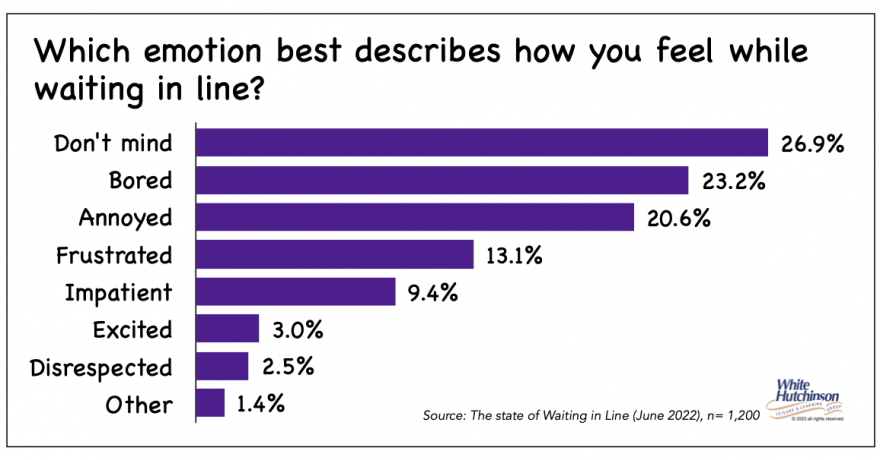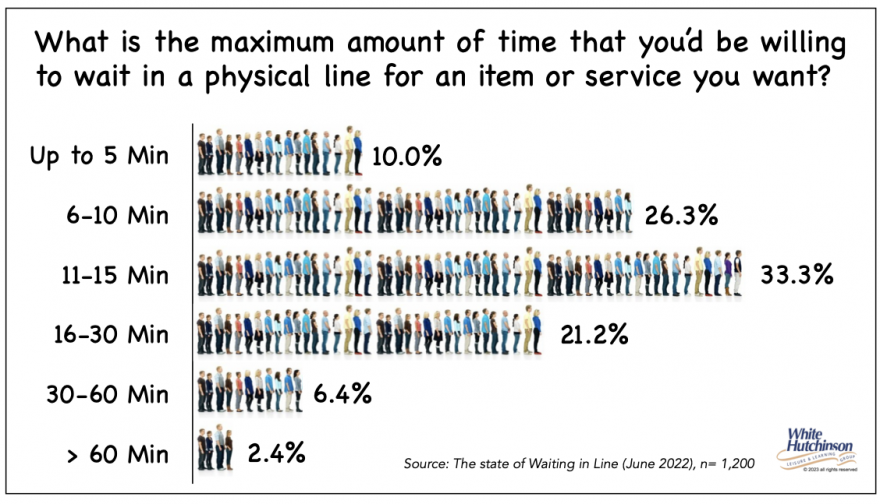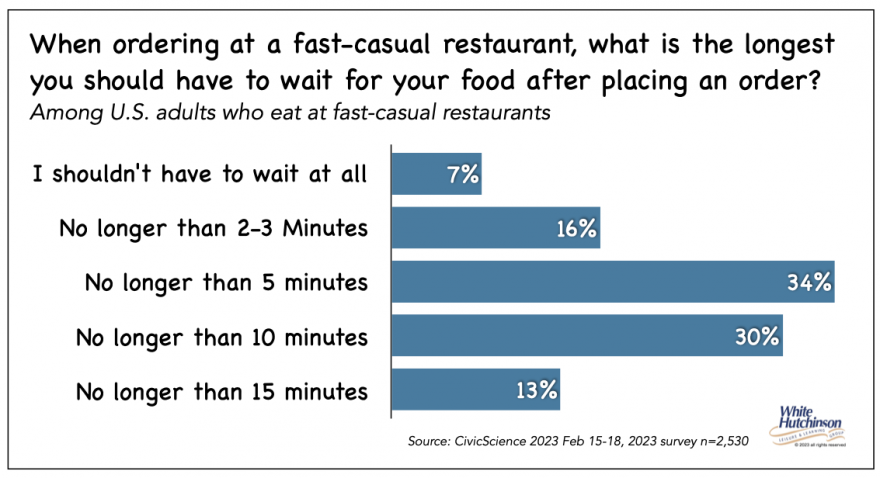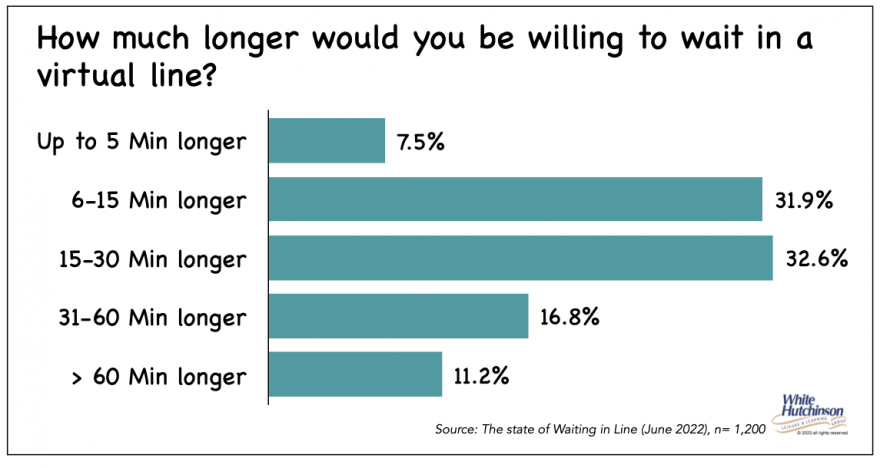
Vol. II, No. 1, January 2024
Long lines are not good for business

Agritourism businesses typically end up with customer lines. It could be a line waiting to order food, to check out from a store, or to purchase tickets for a ride or activity. Regardless, no one likes to wait in a line. Waiting in line has been called a "timeless form of torture." If the wait seems too long, customers will often bail out and abandon what they were waiting to do or buy, negatively impacting the business's reputation and profit. Due to the importance of not having customers wait too long in lines, the dynamics of customer line wait times and queue design have received a lot of research.
These are the findings from a 2023 Waitwhile report, The State of Waiting in Line . The vast majority of people view waiting in line negatively. 44% of consumers are less satisfied with a business that has lines. Only a little more than a quarter of Americans (27%) don't mind waiting in a line, meaning that nearly 75% of consumers will experience an adverse emotion. This is critical as a lot is at stake for a business during the queuing process: a poor waiting experience can derail an entire visit, ultimately hurting a business's bottom line.

Nearly 69% say waiting in line elicits negative feelings, including boredom, annoyance, frustration, and impatience. Remarkably, fewer than 3% of people associate waiting with something positive to look forward to ("Excited"). This indicates that consumers do not want to wait even when acquiring highly desirable products or services.
Given the negative emotions that waiting in a physical line elicits, it's unsurprising that in-person queues have such a high abandonment rate. Nearly 75% said they sometimes leave a physical line before it's their turn, while fewer than half of Americans leave virtual lines.
Envirosell, an international retail consultancy, has timed retail shoppers in line to determine how actual wait times compared with how long shoppers felt they had waited. Up to about two to three minutes, the perception of the wait "was very accurate," says Paco Underhill, Envirosell's founding president. However, after three minutes, the perceived wait time seems longer than it actually was with each passing minute. "So, if the person was actually waiting four minutes, the person said, 'I've been waiting five or six minutes.' If they got to five minutes, they would say, 'I've been waiting 10 minutes," Mr. Underhill says.
Men are more likely to give up and abandon a line than women. Men start to inflate the perceived time after only two minutes versus three for women.
The Waitwhile report found that 48% of consumer leave a physical line before it's their turn 25% of the time, and 20% leave 50% or more of the time.
The maximum time people are willing to wait in a queue line can vary depending on the situation and individual preferences. However, according to Eric Kant, founder of Phase01 Crowd Management, a Dutch company that manages events, "the perfect queue is one that doesn't take longer than 10 minutes."
The report by Waitwhile found that 70% of those surveyed said they are willing to wait only a maximum of 15 minutes in a physical line for an item or service.

Guests between 18 and 44 will most likely leave a physical line before it's their turn.
For fast-casual restaurant diners, such as at Panera Bread or Chipotle, the highest concentration of maximum wait time falls between 5 minutes (34%) and 10 minutes (30%)

A 2019 study by Oracle found that 45% of fans at sports venues have given up waiting in line for food or drink. Nearly six in ten fans (59%) said they would spend more on concessions if wait times were cut in half. According to the study, ten minutes was the maximum acceptable wait time to buy food and drinks.
Dr. Janakiraman, assistant professor of marketing at Eller College of Management at the University of Arizona, is the lead author of a published research paper on how impatient shoppers get in lines. Dr. Janakiraman concluded shoppers are likely to abandon a line that might take between one and 10 minutes longer to get through after the first two or three minutes if they feel it isn't moving fast enough for them.
A research study from Columbia University Business School in New York found there is a sensitivity to queue length based on customers' sensitivity to prices - the customers who purchase the most premium items are least sensitive to pricing and most sensitive to wait time. Hence, long queues are particularly harmful for the most profitable customer segments.
The most efficient design of lines when there is more than one cashier or transaction point is counterintuitive. A single, serpentine line that feeds into multiple service points is considered the fastest and fairest way to move waiting people. Surveys show that many people will wait longer in line for fast food if the establishment has a single queue ordering system instead of a multi-queue multi-register setup. A single-file line leading to three cashiers is about three times faster than having a separate line for each cashier. The reason is that at least one line could be held up by some random event like the customer's credit card not working, the price missing from an item, or the customer getting into a long conversation with the cashier, what is called a line stopper. With a single line, the line stopper will only hold up one register while the line keeps moving through the other two. Additionally, a single line moves faster, reducing the feeling of unfairness and the need for customers to switch lines in search of the fastest one.
Many agritourism businesses end up with excessively long lines as they fail to provide enough order and transaction points based on busy times. When the business started, there were often adequate order and transaction points. But as the business grew in volume, the number became inadequate. Another factor that can lead to excessively long lines is waiting for food orders at a concession stand. This is often a function of kitchen design, its size, and/or the number of different pieces of kitchen equipment. For example, if French fries are a part of combo meals, there needs to be enough fryers dedicated to French fries to cook the number of portions of fries to accommodate the number of combo meals. Menu design also impacts the length of lines and waits. If the menu includes food items that take a long time to cook, that will make for long waits for customers to get their food.
Pre-Covid, many agritourism businesses experienced long lines on their peak attendance days. It doesn't make economic sense to design a kitchen and the number of order points for the very busiest day of the year, any more than it makes sense for a shopping mall to size the parking lot for Black Friday. Covid restrictions forced many farms to limit their capacity. To do this, the farms went exclusively to a pre-paid reservation system to control their maximum capabilities. Some have continued this system, only allowing walk-ins if capacity hasn't been reached. This makes it possible to avoid peak attendance days when the number of people exceeds what the venue was designed to handle at any one time and over-crowing, which diminishes the customer experience. This also helps to alleviate long lines.
Another partial solution is to have virtual queues whenever possible. The Waitwhile report found that 57% of consumers prefer virtual queues, and nearly two-thirds of people (64%) are willing to wait longer in a virtual queue.

Conclusion
Long lines are bad for business. They will reduce sales and profit, leave customers dissatisfied, frustrated, and with a negative image of the business, possibly resulting in negative reviews, a bad reputation, and lost repeat business. They can also create a stressful environment for staff, making retention and hiring more challenging.
Subscribe to Agritourism Today



